What Are CBG Gummies and How to Pick Them?
Summarize
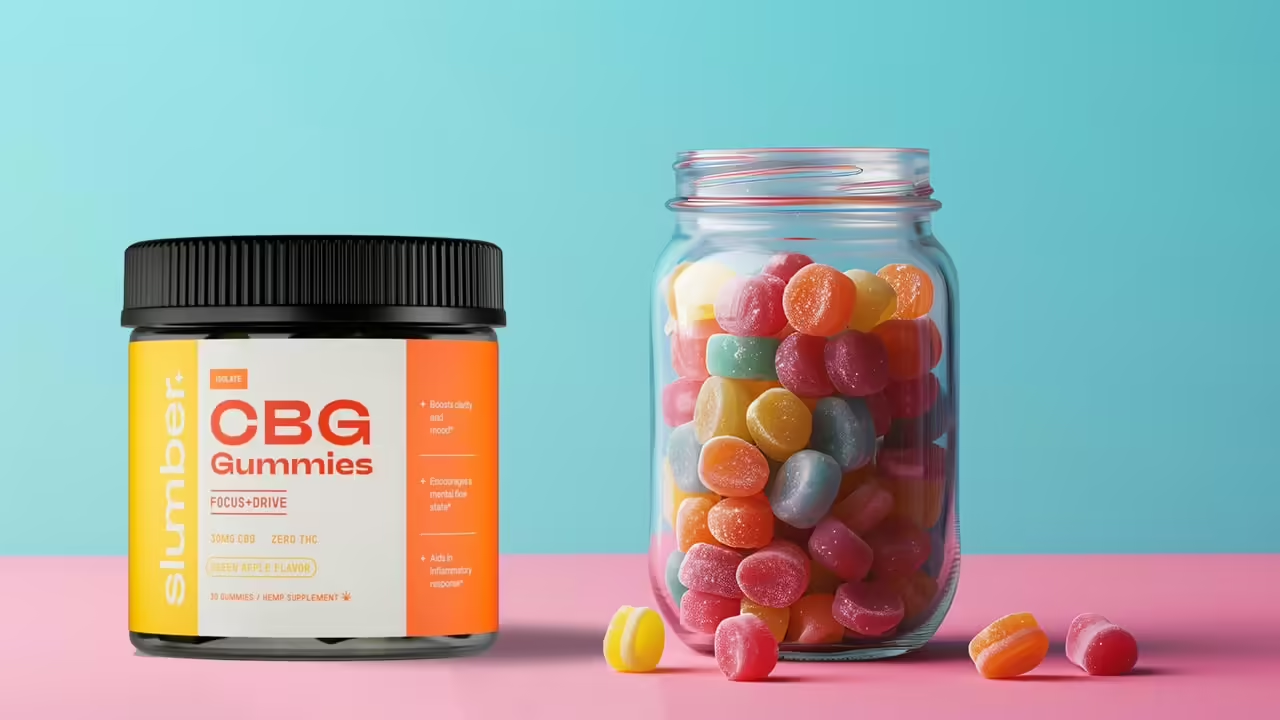
The world of cannabinoids continues to expand as researchers expand their studies to assess the potential of the natural compounds in the hemp plant to support wellness. CBG is one of at least 140 cannabinoids in the cannabis plant, and it is increasingly gaining attention for its unique properties. CBD manufacturers are adding CBG to their CBD products because CBG offers potential benefits that complement CBD. One of the easiest ways to take it is by consuming CBG gummies.
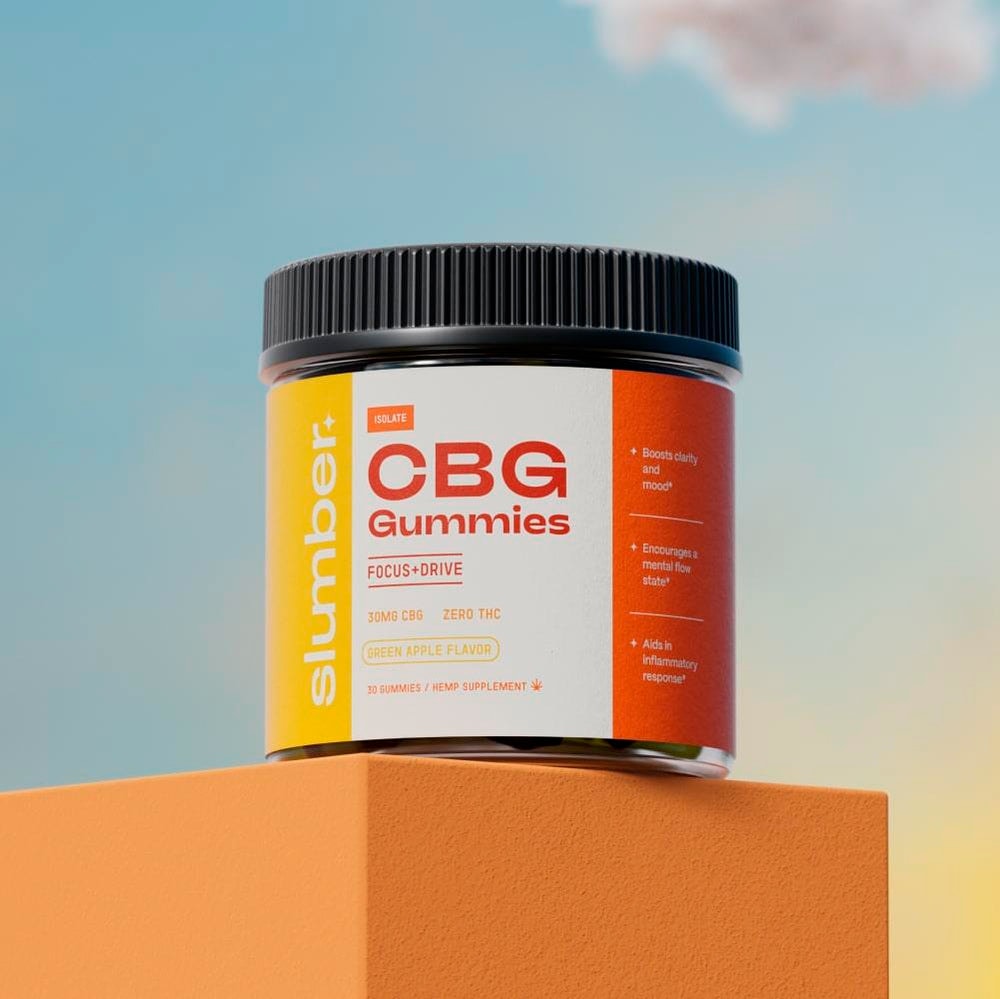
TL;DR (Too Long; Didn’t Read):
CBG is a minor cannabinoid in the cannabis plant. It is a precursor to CBG, CBD, and THC and is non-psychoactive. Research is limited but has demonstrated that CBG may offer many benefits, including antioxidant power, improving sleep quality and focus, and providing neuroprotection. Gummies are a delicious way of consuming CBG. They often contain other cannabinoids, like CBD, and health-promoting natural ingredients like lemon balm and chamomile.
Table of Contents
What Are CBG Gummies?
Gummies are soft, chewable candies available in various flavors. They are made with pectin or gelatin to give the candy its chewy texture.
CBG gummies are a type of candy infused with CBG (Cannabigerol), one of the non-psychoactive cannabinoids in the cannabis plant. CBG is extracted from hemp, a type of cannabis plant that has less than 0.3% THC.
CBGA is a precursor to the formation of CBG, CBD, and THC. It undergoes a biosynthesis process (decarboxylation) that converts CBGA to CBG, CBDA, and THCA. CBDA and THCA are then converted into CBD and THC when the plant is exposed to heat and sunlight. Because a good amount of CBGA ends up as CBD and THC, there is not much CBG in older plants.
Like CBD, CBG in gummies works with the endocannabinoid system (ECS). Research to date has found that CBG is a partial agonist of the CB1 and CB2 receptors in the ECS. A partial agonist is a compound that activates the receptors but not to the fullest degree possible. CBG is also a regulator of ECS signaling.
Since CBG is converted as young cannabis plants grow, it is available in much smaller amounts than CBD or THC. CBG is infused into CBD gummies during the manufacturing process. Some of the product features to consider include the following.
- Amount of CBG per gummy, i.e., 5 mg, 10 mg, 15 mg, etc.
- The benefits the CBG gummies are formulated to provide, i.e., sleep, mood, neuroprotection, etc.
- Additional ingredients include chamomile, lemon balm, reishi mushroom extract, Lion’s Mane, turmeric, etc.
- Flavor, i.e., pear, fruit punch, orange, lemon, mango, green apple, etc.
- Availability of the Certificate of Analysis (COA)
- Brand reputation based on CBG reviews
- Whether the product is vegan or free of artificial ingredients
- Source of the sweetener, i.e., honey, corn syrup, sugar, fruit juices, etc.
Most gummies infused with CBG are CBD gummies made with additional amounts of CBG and other cannabinoids, like CBC and CBN. The full spectrum CBD gummies with CBG have all of the hemp plant cannabinoids, terpenes, and flavonoids, and no more than 0.3% THC plus additional CBG infusions. The broad spectrum CBD gummies are the same, except the THC is removed during processing, so they are THC-free.
There are also isolate CBG gummies available. Isolate indicates pure CBG was infused in the gummies. Some isolate products are made with isolate CBD plus isolate CBG. All isolate gummies are THC-free.
Potential Benefits of CBG Gummies
CBG needs much more research to understand its benefits fully. However, the research to date has found a number of potential positive effects from consuming CBG edibles like gummies. The following are some of the CBG gummy benefits that clinical trials have reported.
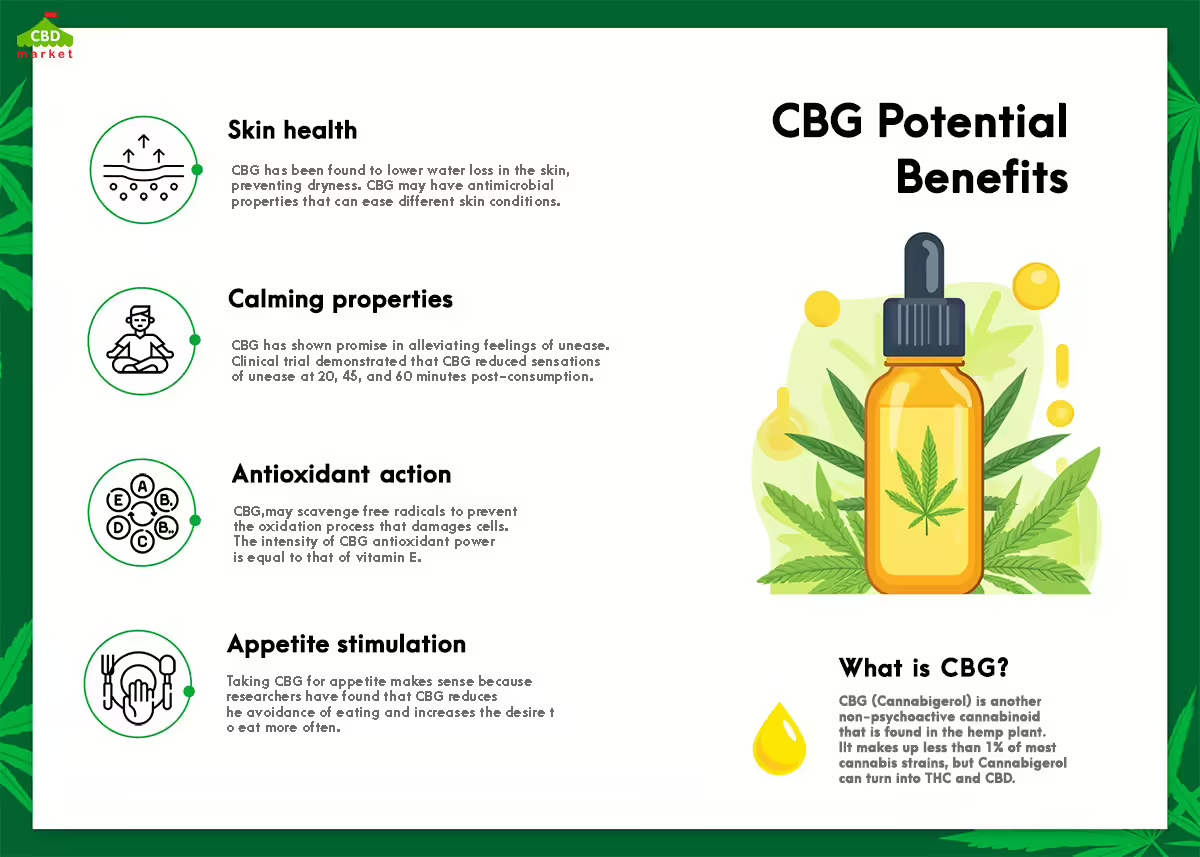
1. Antioxidant effects
CBG has been reported to protect cells from oxidative imbalance. Cells damaged by this process (free radicals) are a significant source of irritation, leading to DNA damage and premature aging.
2. Calming effects
CBG has shown promise in alleviating feelings of unease and apprehension. Pre-clinical research indicates a notable decrease in general unease, with multiple studies revealing that 78% of participants found CBG to be more effective than traditional medications for managing such feelings. The initial human clinical trial demonstrated that a 20 mg dose of hemp-derived CBG reduced sensations of unease at 20, 45, and 60 minutes post-consumption.
3. Neuroprotection
CBG appears to have the ability to reduce anandamide uptake, which means it increases anandamide levels. Anandamide is an endocannabinoid and neurotransmitter and plays a role in vasodilation. CBG may promote blood flow to the brain, improving memory and focus.
4. Skin health
CBG has been found to lower water loss in the skin, preventing dryness. CBG may have antimicrobial properties that can help alleviate various skin conditions.
5. Appetite stimulation
The ability of CBG to stimulate appetite (hyperphagia) is well documented. Taking CBG for appetite makes sense because researchers have found that CBG reduces the avoidance of eating and increases the desire to eat more often.
6. Alleviates discomfort
CBG can activate TRPV1 and CB2 receptors, which are involved in discomfort signaling. By exerting antinociceptive effects, CBD may help alleviate feelings of discomfort. Researchers found that CBD can activate TRPV1 receptors to block signaling. It can activate CB2 to stimulate the release of β-endorphins.
7. Promotes good sleep
A survey of consumers of CBG-prominent products found that 30.7% of users were taking the cannabinoid to improve sleep. Additionally, 73% reported that CBG products were more effective than conventional medicines for such issues.
There are also clinical studies that have demonstrated that CBD and CBG accelerate the body’s absorption of minerals, thereby strengthening new bone growth.
Potential Risks of CBG Gummies
Since CBG research is limited, little is known about potential CBG side effects. Side effects reported to date by consumers taking a product that is CBG-predominant are not serious. They include effects like dry mouth, dry eyes, increased appetite, and sleepiness.
The Food and Drug Administration does not regulate CBG products. Therefore, reviewing the Certificate of Analysis (COA) prepared by an independent laboratory is important.
There is always a risk that a natural plant compound may interfere with medications. Since CBG may affect blood vessels and blood pressure, mood, etc., you should always talk to your doctor before taking CBG or any other cannabinoid products.
CBD vs. CBG Gummies: What’s the Difference Between Them?
Though CBG and CBD are both cannabinoids, they do have some differences. Their molecular structures are different, influencing how cannabinoids interact with the endocannabinoid system. For example, CBG interacts with cannabinoid receptors in a way that is between how THC and CBD interact. It acts uniquely in its interactions with alpha-2 adrenoceptors, which influence blood pressure, and 5-HT1A receptors, which affect mood.
Some other differences include the following.
- CBD is a major cannabinoid, while CBG is a minor one
- CBD is a better-known cannabinoid because much more research is available
- CBD may reduce appetite, while CBG may increase appetite
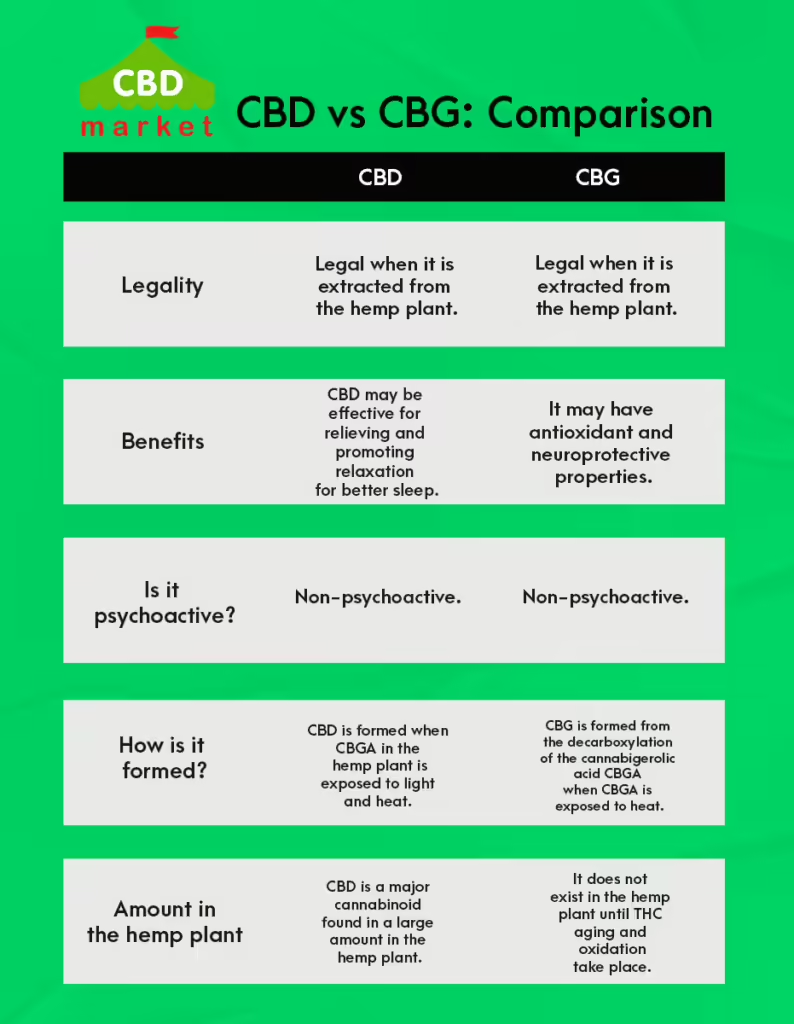
How to Use CBG Gummies?
CBG gummies are meant to be chewed like candy, and you can consume gummies daily. When you consume them, it depends on what the CBG gummies were formulated to address. For example, a CBG gummy for sleep could be taken an hour before bedtime. A CBG gummy that promotes general wellness could be taken in the morning and later in the day as needed.
Gummies can be consumed at any time of the day, and you can take them more than once per day. However, starting with low-potency CBG gummies would be best, allowing you to assess the effects more effectively. You can increase your dosage and try taking CBG gummies more than once a day after you know how your body reacts to them.
How to Choose CBG Gummies?
Choosing CBG gummies starts with your goal. If you want calm focus for daytime, look for THC-free isolate or broad spectrum gummies with higher CBG and no sedating add-ins. If you’re comfortable with trace THC and want a fuller hemp profile, full spectrum may suit you. For sleep support, consider formulas that also include CBN or melatonin; for general wellness, a simple CBG or CBG+CBD blend is a good fit.
Next, read the label. Check the CBG mg per gummy and the total CBG per jar, as well as any cannabinoid ratio. Verify a batch-matched COA for potency and contaminant testing. Scan ingredients (pectin, vegan vs. gelatin, sugars per gummy, allergens, dyes). Compare values fairly by calculating the price per mg of CBG. If you’re new, start with a lower-potency option to see how you respond, and then adjust accordingly. Favor brands with clear labels, easy access to COAs, reliable reviews, and customer-friendly policies.
| Product | Spectrum | Servings | CBG per gummy | Price per bottle | Price per gummy |
|---|---|---|---|---|---|
Lazarus Naturals CBD+CBG Gummies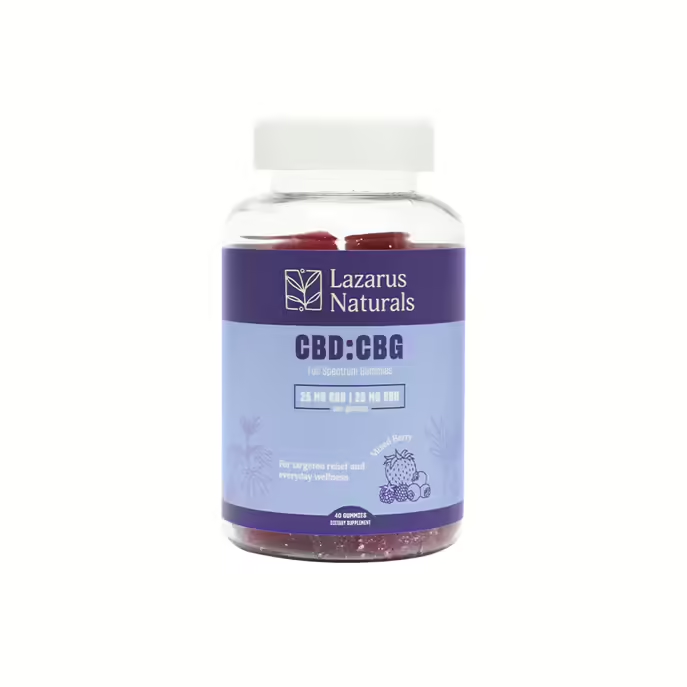 | Full Spectrum | 40 | 25 mg | $50.99 | $1.27 |
Wyld CBD Pear Gummies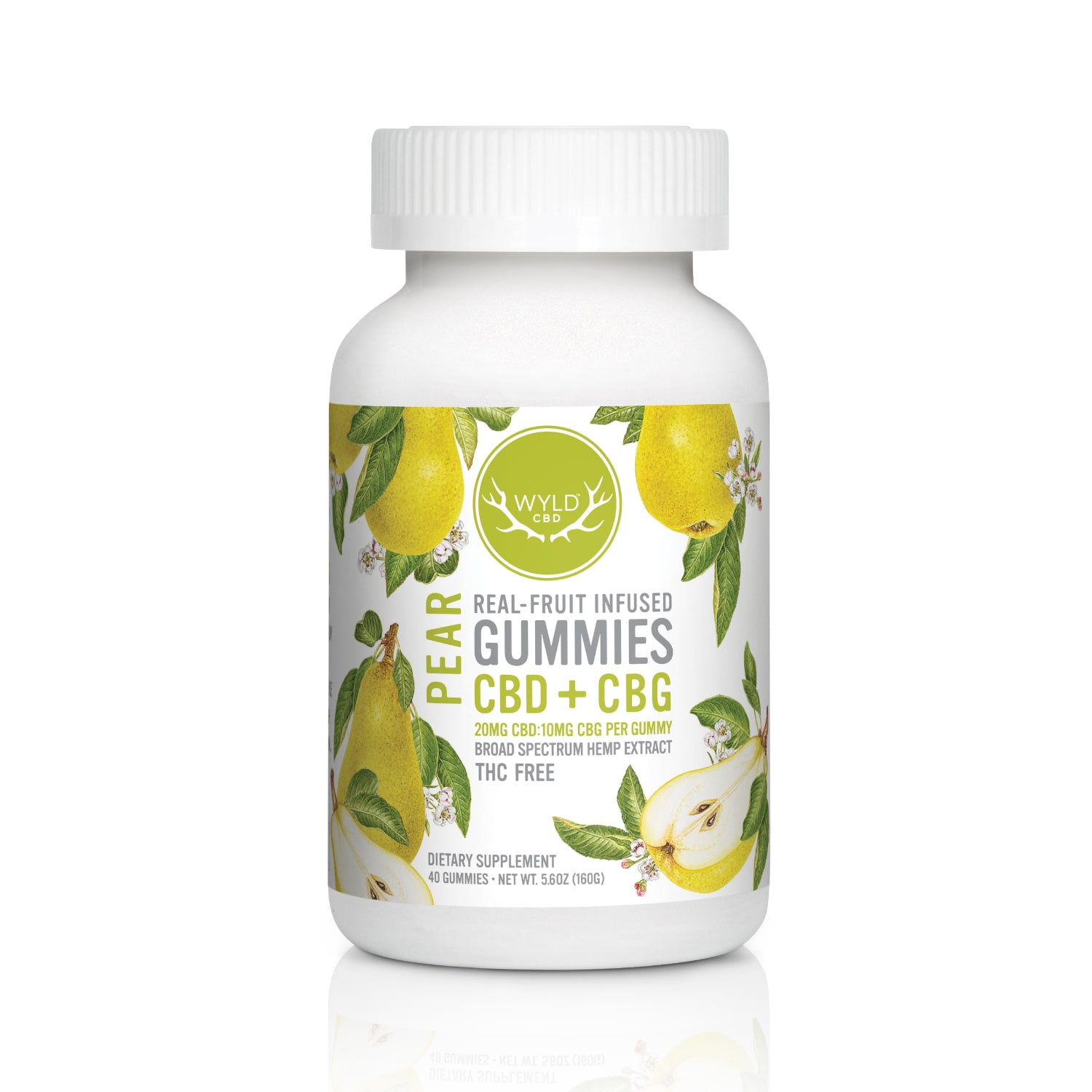 | Broad Spectrum | 40 | 10 mg | $47.95 | $1.20 |
Hemp Bombs CBG + CBD Gummies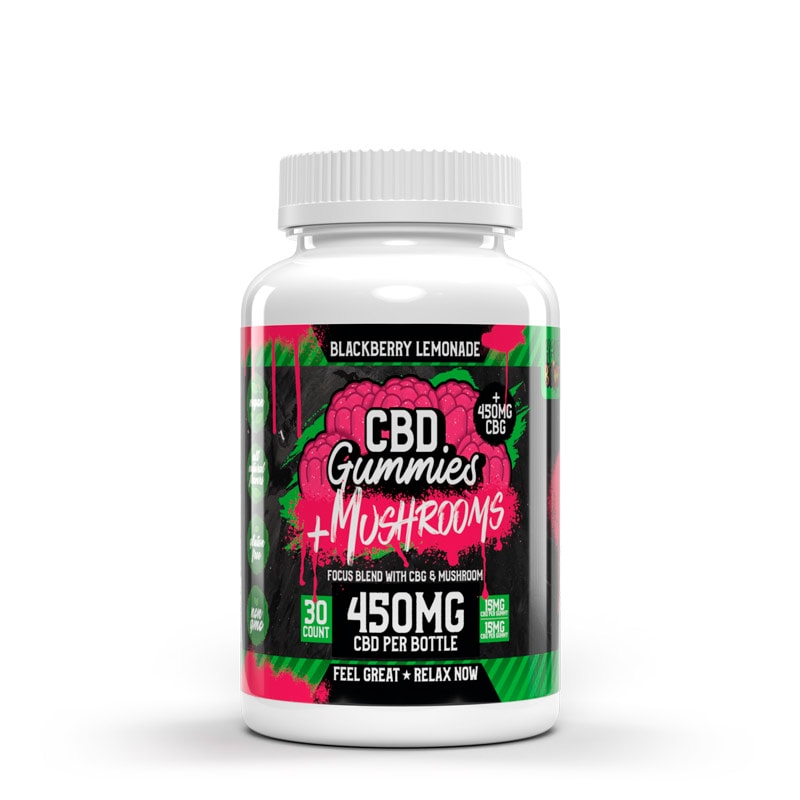 | Isolate | 30 | 15 mg | $25.50 | $.85 |
Wyld CBD Sour Apple Refresh CBD+THC Gummies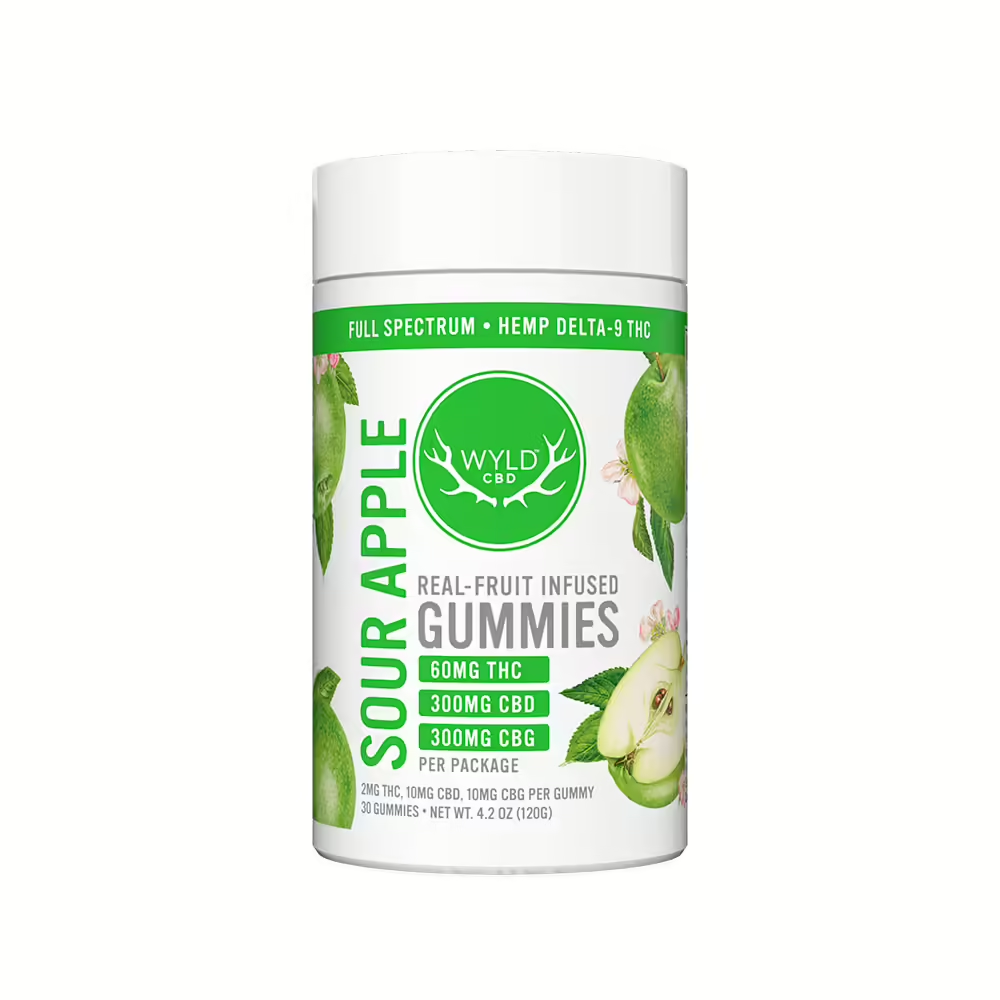 | Full Spectrum | 30 | 10 mg | $39.95 | $1.33 |
Slumber Extra Strength CBG Gummies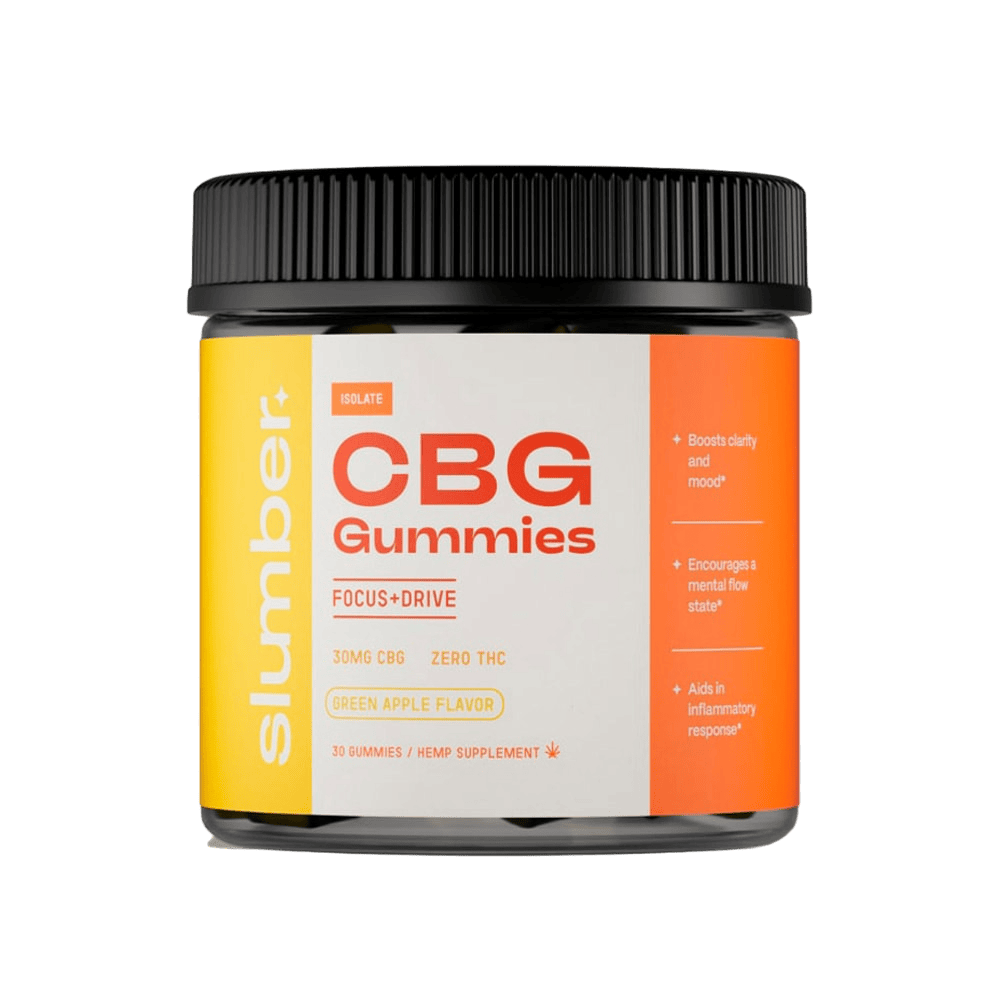 | Isolate | 30 | 30 mg | $47.99 | $1.60 |
FAQs
What Are CBG Gummies Good for?
Limited research on the benefits of CBG gummies suggests that CBG may deliver many benefits. These include appetite stimulation, neuroprotection, skin protection, mood improvement, better sleep, and more. Although more research is needed, CBG has consistently been shown in clinical studies to have numerous positive effects.
Are CBG Gummies Legal?
CBG gummies are legal at the federal level as long as the THC content is less than 0.3% because the cannabinoids were extracted from the hemp plant. However, state laws may differ from federal laws.
Will CBG Gummies Get You High?
CBG gummies are non-psychoactive and will not get you high.
When to Consume CBG Gummies?
The purpose of the CBG gummies was to address factors that influence when you will want to consume the gummies. If you want better sleep, you should consume CBG gummies an hour before bedtime. To improve focus or support wellness, you can take a serving in the morning and additional servings throughout the day as needed. Start slow with a low-potency gummy, and take more gummies only after determining the effects.
Does a CBG Gummy Make You Sleepy?
A CBG gummy may make you sleepy, but this could be because it eases issues that cause discomfort. CBG has calming effects that support better sleep.
Take Advantage of the Power of Cannabinoids
Through clinical studies, CBG is proving to be another cannabinoid that may deliver many positive effects. Researchers are supporting more research due to its potential therapeutic value for overall well-being. CBG is not federally regulated, so purchasing your CBG gummies only from a brand that publishes a Certificate of Analysis and has a good reputation among consumers is essential.
Sources
- Cuttler, C., Stueber, A., Cooper, Z. D., & Russo, E. (2024). Acute effects of cannabigerol on mood: a double-blind, placebo-controlled, crossover, field trial. Scientific Reports, 14, 16163.
- Ferguson, W. (2024, July 31). ScienceDaily.
- Echeverry, C., Prunell, G., Narbondo, C., Sánchez de Medina, V., Nadal, X., Reyes-Parada, M., & Scorza, C. (2021). A Comparative In Vitro Study of the Neuroprotective Effect Induced by Cannabidiol, Cannabigerol, and Their Respective Acid Forms: Relevance of the 5-HT1A Receptors. Neurotoxicity Research, 39, 335–348.
- Nachnani, R., Raup-Konsavage, W. M., & Vrana, K. E. (2021). The Pharmacological Case for Cannabigerol. Journal of Pharmacology and Experimental Therapeutics, 376(2), 204-212.
- Luz-Veiga, M., Amorim, M., Pinto-Ribeiro, I., Oliveira, A. L. S., Silva, S., Pimentel, L. L., Rodríguez-Alcalá, L. M., Madureira, R., Pintado, M., Azevedo-Silva, J., & Fernandes, J. (2023). Cannabidiol and Cannabigerol Exert Antimicrobial Activity without Compromising Skin Microbiota. International Journal of Molecular Sciences, 24(3), 2389.
- Brierley, D. I., Samuels, J., Duncan, M., Whalley, B. J., & Williams, C. M. (2016). Cannabigerol is a novel, well-tolerated appetite stimulant in pre-satiated rats. Psychopharmacology (Berl), 233(19), 3603–3613.
- Wen, Y., Wang, Z., Zhang, R., Zhu, Y., Lin, G., Li, R., & Zhang, J. (2022). The antinociceptive activity and mechanism of action of cannabigerol. Biopharmaceutics & Drug Disposition.
- Nachnani, R., Sepulveda, D. E., Booth, J. L., Zhou, S., Graziane, N. M., Raup-Konsavage, W. M., & Vrana, K. E. (2023). Chronic Cannabigerol as an Effective Therapeutic for Cisplatin-Induced Neuropathic Discomfort. Pharmaceuticals, 16(10), 1442.
- Russo, E. B., Cuttler, C., Cooper, Z. D., Stueber, A., Whiteley, V. L., & Sexton, M. (2022). Survey of Patients Employing Cannabigerol-Predominant Cannabis Preparations: Perceived Medical Effects, Adverse Events, and Withdrawal Symptoms. Cannabis and Cannabinoid Research.
- Sweger, Z. (2023, October 24). CBD and CBG may promote bone fracture healing. Penn State College of Medicine.
- Russo, E. B., Cuttler, C., Cooper, Z. D., Stueber, A., Whiteley, V. L., & Sexton, M. (2022). Survey of Patients Employing Cannabigerol-Predominant Cannabis Preparations: Perceived Medical Effects, Adverse Events, and Withdrawal Symptoms. Cannabis and Cannabinoid Research.
Share this post


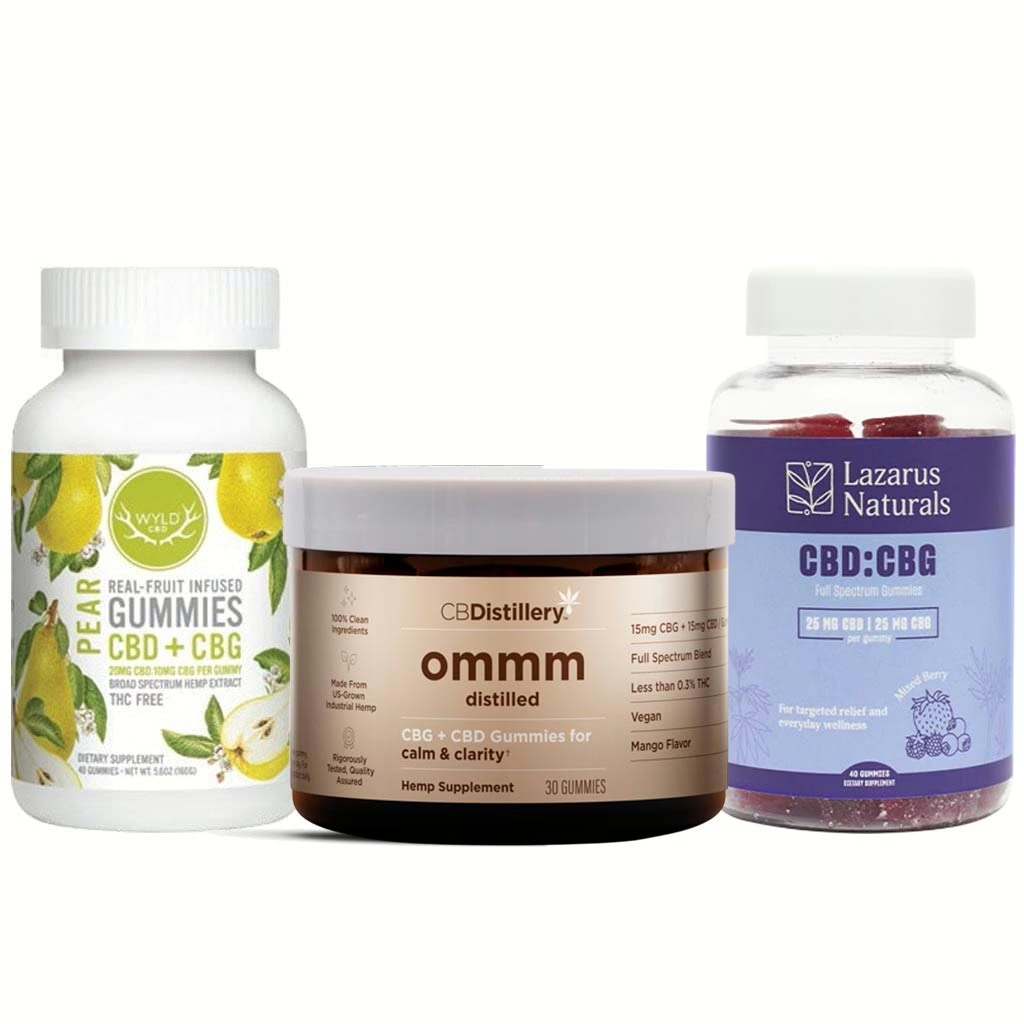
0